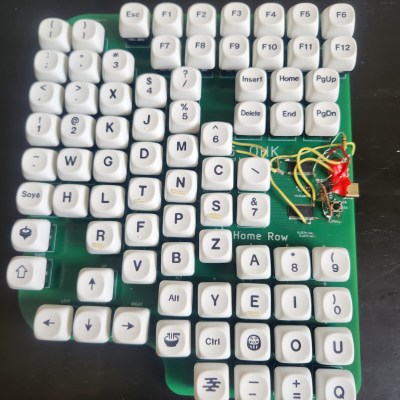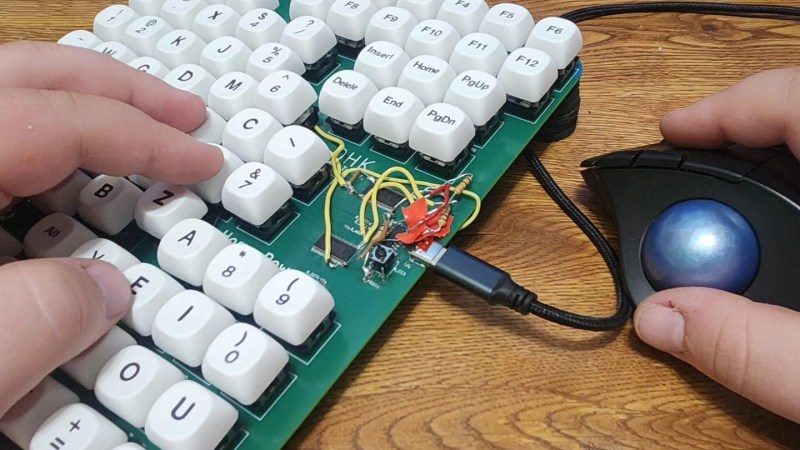Most one-handed keyboards rely on modifier keys or chording (pressing multiple keys in patterns) to stretch the functionality of a single hand’s worth of buttons. [Dylan Turner]’s PS-OHK takes an entirely different approach, instead putting 75 individual keys within reach of a single hand, with a layout designed to be practical as well as easy to get used to.

The main use case of the PS-OHK is for one hand to comfortably rest at the keyboard while the other hand manipulates a mouse in equal comfort. There is a full complement of familiar special keys (Home, End, Insert, Delete, PgUp, PgDn) as well as function keys F1 to F12 which helps keep things familiar.
As for the rest of the layout, we like the way that [Dylan] clearly aimed to maintain some of the spatial relationship of “landmark” keys such as ESC, which is positioned at the top-left corner of its group. Similarly, arrow keys are grouped together in the expected pattern.
One-handed keyboards usually rely on modifier keys or multi-key chording and it’s interesting to see work put into a different approach that doesn’t require memorizing strange layouts or input patterns.
Want to make your own? The GitHub repository has everything you need. Accommodating the 75 physical keys requires a large PCB, but it’s a fairly straightforward shape and doesn’t have any oddball manufacturing requirements, which means getting it made should be a snap.















I use a regular full size keyboard one handed just fine. 60 WPM. I do still want to make a chord keyboard though.
That’s great, but some of us have short fingers lol
I only get about 40 one-handed on a regular, just over half my two-handed speed
I’m hoping this will allow me to exceed even my two-handed speed with enough practice due to the efficient layout
Well, short fingers aren’t going to have any fun on this atrocity.
Sorry, misspelled. I meant “gem”.
Everything is much closer, actually. It’s very easy to reach it all :)
Quote: “The main use case of the PS-OHK is for one hand to comfortably rest at the keyboard while the other hand manipulates a mouse in equal comfort.”
Or manipulates a glass of beer. I’m very much in favor.
nifty design, never seen a keyboard where the thumb actually runs multiple letter keys
so its a less ergonomic Maltron
We can’t help but notice Space also isn’t obvious in the prototype.
Space is under E. I didn’t have a 1u Space cap so I used a key with a face. Bc space rhymes with face
I have been updating this a bit.
I’ve fixed a couple things:
– Forgotten connections (just didn’t run the DRC ig)
– Added forgotten Backspace (was using Delete as backspace and Alt + Delete for delete as a temp software fix)
– Added missing C key (C is actually where 6 was with a new 6 bodged in on the prototype; you can tell if you look closely)
– Moved K down to next to R
I also split the surface mounted control electronics off to their own board. This saves cost when ordering PCB assembly and makes it easier to modify the key layout down the line.
The added flexibility means I’ve also been able to make a right-handed version to allow the design to serve a secondary purpose as an accessibility keyboard.
P.S. I typed my comment with the prototype :)
I’m already up from 12 wpm to 22 after just a couple days of using it. 100 wpm here I come!
I have accomplished the same thing with reconfigurable keyboards from ErgoDex. Great stuff back when they were available. I still use it for PCB design.
“… a different approach that doesn’t require memorizing strange layouts …” Waaat?!?
Interesting project; I wish you well. I’ve never been a fan of chording keyboards.
“We can’t help but notice Backspace isn’t obvious in the prototype, but it’s also a work in progress.”
The delete key? In my day2day it would be more difficult to deal with not having some of the dedicated redundant keys as many shortcuts specify left or right shift in their combination. Easy enough to change, but having to do so for every instance would be tedious, especially if using multiple machines. do love to see some weird keyboards though. also tosses wasd way off, so it’d be worthwhile to just grab a gamepad for the left hand… way obvious if in a work environment that you’re slacking instead of grinding your soul out to make someone else rich. If the creator reads this, an idea is just to chuck a few macro keys on it. Program wtf ever is missing for x use case. looks good.
Interesting idea, but WASD seems like it would be hard to reach.
How did you choose the positions for the keys?
I want to see this used by a movie hero hacker saving the world.
Can’t be a Vim user, though. =)
Although, since Vim uses not much chording it should work rather nice…